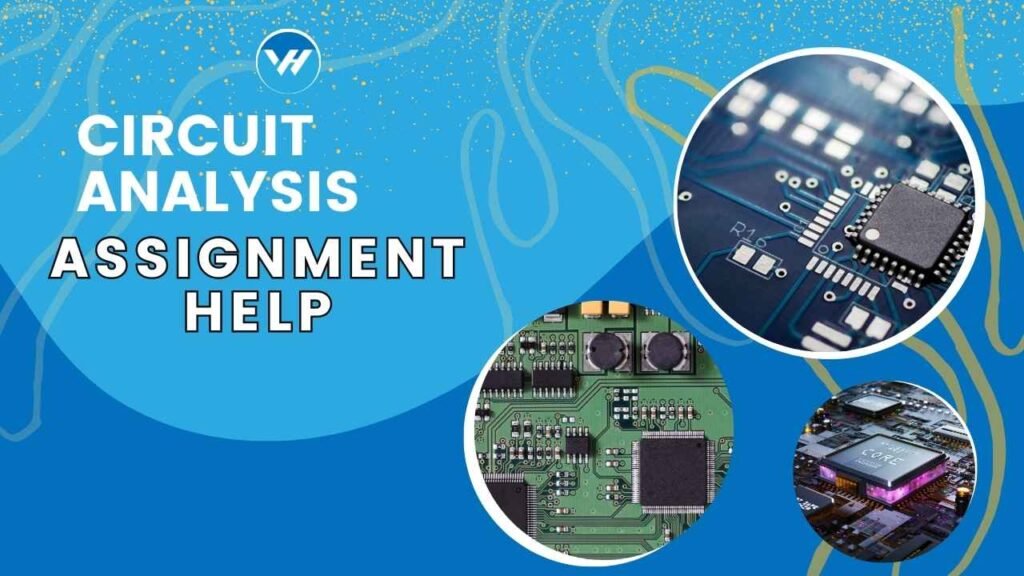When diving into the world of electrical engineering, Circuit Analysis stands as a cornerstone. It’s the method used to understand how electrical circuits operate, involving the study of various components and their interactions. For students, mastering circuit analysis is crucial, yet it often proves to be a challenging aspect of their studies. Whether it’s grappling with theoretical concepts or applying them to complex problems, many students find themselves needing extra assistance. This is where tailored help with circuit analysis assignments becomes invaluable.

Table of Contents
ToggleUnderstanding Circuit Analysis
Basics of Circuit Analysis
Before diving into the intricacies, let’s break down the basics. Circuit analysis involves understanding how electrical components interact within a circuit.
- Electrical Components: Key elements like resistors, capacitors, and inductors form the building blocks of circuits. Each plays a unique role:
- Resistors limit the flow of current.
- Capacitors store and release electrical energy.
- Inductors oppose changes in current flow.
- Circuit Theorems: Fundamental rules like Ohm’s Law and Kirchhoff’s Laws guide the analysis.
- Ohm’s Law states that V=IRV = IRV=IR, where VVV is voltage, III is current, and RRR is resistance.
- Kirchhoff’s Laws include Kirchhoff’s Voltage Law (KVL) and Kirchhoff’s Current Law (KCL), which are essential for solving circuit problems.
Types of Circuits
- Series Circuits: Components are connected end-to-end, so the same current flows through each component, but the voltage divides across them.
- Parallel Circuits: Components are connected across common points, so each component experiences the same voltage, but the current divides.
Common Challenges in Circuit Analysis
Many students face challenges when tackling circuit analysis assignments:
- Difficulty in Applying Theoretical Concepts: Translating theoretical knowledge into practical problems can be daunting. For example, understanding how to apply Kirchhoff’s Laws in a complex circuit with multiple loops and nodes can be confusing without guided practice.
- Troubleshooting Circuit Problems: Identifying and fixing errors within a circuit requires both skill and patience. It involves meticulous checking of connections, values, and calculations to ensure everything is functioning as expected.
- Time Management: Balancing complex circuit problems with other academic responsibilities can be overwhelming. The extensive time required to analyze and solve intricate circuit problems can make it challenging to meet deadlines.
How to Approach Circuit Analysis Assignments
Step-by-Step Problem-Solving Techniques
- Identifying the Problem: Carefully read the problem statement to understand what’s being asked. Identify the type of circuit, the components involved, and the specific quantities you need to find.
- Applying Relevant Theorems: Use circuit theorems and laws to set up equations based on the given circuit. For instance, apply Ohm’s Law to find voltage across a resistor or use KVL to write loop equations.
- Calculations and Verifications: Perform calculations meticulously and double-check your results. Ensure your units are consistent, and verify your answers by checking if they satisfy all the initial conditions and constraints.
Tips for Efficient Assignment Completion
- Break down the assignment into manageable parts. Focus on solving one section or problem at a time.
- Prioritize tasks based on difficulty and deadline. Tackle the most challenging problems first when your mind is fresh.
- Use diagrams and step-by-step calculations to keep track of your work. Visual aids can help clarify complex relationships and interactions within the circuit.
Online Resources for Circuit Analysis Help
There’s a wealth of online resources available:
- Tutorials and Video Lectures: Websites like Khan Academy, Coursera, and YouTube offer comprehensive tutorials on circuit analysis, covering both basic and advanced topics.
- Interactive Simulations: Tools like PhET Interactive Simulations and CircuitLab provide hands-on practice with virtual circuits, allowing you to experiment with different configurations and see real-time results.
- Forums and Study Groups: Platforms like Reddit, Stack Exchange, and specialized forums host discussions where you can seek advice, ask questions, and share knowledge with peers and experts.
Virtual Help: Your Go-To Platform for Circuit Analysis Assistance
Overview of Virtual Help
Virtual Help is a robust platform designed to assist students with their assignments. With a dedicated app available on iOS and Android, it connects students with expert tutors in various fields, including circuit analysis. Virtual Help offers a convenient and reliable way to get the help you need, when you need it.
How Virtual Help Works
- Find a Tutor: Browse through profiles and select a tutor based on their expertise and your needs. Virtual Help provides detailed profiles, including qualifications, experience, and student reviews, making it easy to find the perfect match.
- Schedule a Session: Set up a convenient time for your tutoring session. The platform’s flexible scheduling options allow you to choose times that fit your busy schedule, including evenings and weekends.
- Get Assistance: Engage in one-on-one sessions to tackle your circuit analysis problems effectively. Tutors use a variety of tools, such as virtual whiteboards and screen sharing, to provide interactive and engaging learning experiences.
Benefits of Using Virtual Help for Circuit Analysis Assignments
- Expert Guidance: Access to knowledgeable tutors who can clarify complex concepts and provide step-by-step explanations.
- Flexible Scheduling: Convenient session times that fit your busy schedule, allowing you to balance study with other commitments.
- Personalized Learning: Tailored assistance that addresses your specific challenges, helping you understand the material deeply and thoroughly.
Finding the Right Tutor on Virtual Help
How to Choose a Tutor
Look for tutors with strong credentials in electrical engineering and positive reviews from other students. Ensure their teaching style aligns with your learning preferences. For instance, if you prefer visual explanations, seek out a tutor who uses diagrams and simulations extensively.
Scheduling and Communication Tips
- Schedule sessions well in advance to ensure availability, especially during peak times like exam periods.
- Communicate your specific needs and concerns before the session to maximize its effectiveness. Share any assignment details, specific problems, or topics you’re struggling with.
Maximizing Your Learning with Virtual Help
Effective Use of Tutoring Sessions
- Come prepared with specific questions or topics you’re struggling with. This helps make the most of your time and ensures you get targeted assistance.
- Take notes during sessions for future reference. Recording sessions (with the tutor’s permission) can also be helpful for reviewing complex explanations.
Supplementing with Additional Resources
- Use online tutorials and practice problems to reinforce what you’ve learned during tutoring sessions. Websites like Khan Academy and CircuitLab offer valuable resources that complement tutoring.
- Join study groups or online forums to discuss problems and solutions with peers, providing additional perspectives and insights.
Tracking Your Progress
- Regularly review your progress and seek feedback from your tutor to continuously improve.
- Set specific goals for each session and track your achievements to stay motivated.
Conclusion
In summary, circuit analysis can be a challenging yet essential part of electrical engineering studies. With the right approach and resources, such as the support offered by Virtual Help, you can overcome these challenges and excel in your assignments. Don’t hesitate to seek help when needed, and make the most of the tools and tutors available to you. By leveraging expert guidance and utilizing additional resources, you can master circuit analysis and achieve your academic goals.
FAQs
What is Circuit Analysis?
Circuit Analysis is the study of how electrical circuits function, including the behavior of components like resistors and capacitors, and applying laws such as Ohm’s Law to solve problems.
How Can Virtual Help Assist with Circuit Analysis Assignments?
Virtual Help connects students with expert tutors who provide personalized guidance and support, helping you tackle complex circuit analysis problems and improve your understanding.
What Should I Look for in a Circuit Analysis Tutor?
Look for tutors with strong credentials in electrical engineering, positive reviews, and a teaching style that suits your learning needs. Ensure they have experience in helping students with similar problems.
How Can I Improve My Skills in Circuit Analysis?
Practice regularly with problems and simulations, use online resources like tutorials and forums, and seek help from experienced tutors to enhance your skills.
Are There Free Resources Available for Circuit Analysis Help?
Yes, there are many free resources online, including tutorials on platforms like Khan Academy, interactive simulations on PhET, and forums where you can get help and advice from peers and experts.





